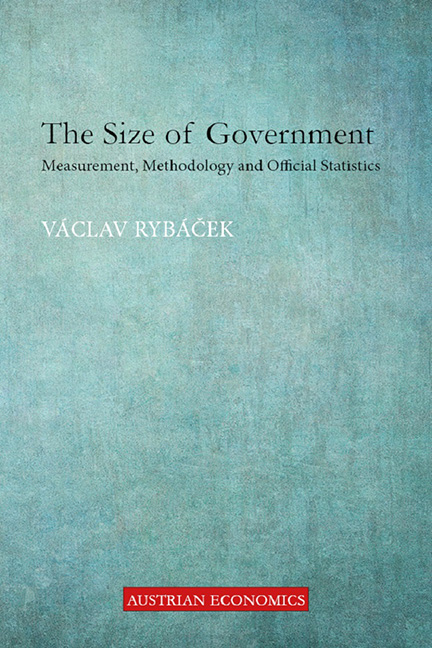Book contents
- Frontmatter
- Contents
- Introduction
- Chapter 1 The Size of Government in Economics
- Chapter 2 The Role of Measuring Government in Economic Policy
- Chapter 3 A Short Trip to the Past
- Chapter 4 The Current Approach
- Chapter 5 What’s Wrong with the Current Approach?
- Chapter 6 The Size of Government and GDP
- Chapter 7 Is the Size of Government Underestimated?
- Chapter 8 Recalculation of the Size of Government
- Conclusion
- Notes
- Bibliography
- Index
Chapter 5 - What’s Wrong with the Current Approach?
Published online by Cambridge University Press: 09 August 2023
- Frontmatter
- Contents
- Introduction
- Chapter 1 The Size of Government in Economics
- Chapter 2 The Role of Measuring Government in Economic Policy
- Chapter 3 A Short Trip to the Past
- Chapter 4 The Current Approach
- Chapter 5 What’s Wrong with the Current Approach?
- Chapter 6 The Size of Government and GDP
- Chapter 7 Is the Size of Government Underestimated?
- Chapter 8 Recalculation of the Size of Government
- Conclusion
- Notes
- Bibliography
- Index
Summary
The statistical conception of market behaviour, as outlined in the previous chapter, obviously opens up many questions. The key one is whether market behaviour can be grasped realistically in a quantitative way. Market mechanism is actually a set of incentives; for its effective operation, the institutional environment matters more than anything else, which is why statisticians have focused their qualitative analysis at the level of competition and other institutional characteristics. However, here we face a serious limitation when it comes to measurability of many of the key features of market behaviour together with a rather arbitrary assessment of what is and what is not true market behaviour.
The issue of measurability is not new. It was Simon Kuznets who reminded us of the fact that measurable phenomenon can be captured statistically only if necessary information is available (Kuznets 1941). Kuznets’s observation on the measurability issue is a great point of departure. As we’ve indicated already the concept of control itself has serious weaknesses. Relying on the majority share is not sufficient, but reflection of partial ownership would make the compilation at the macroeconomic level impractical; moreover, the concept of excessive regulation remains open to its wider application. Nevertheless, not to overcomplicate our point, we will consider the concept of control as sufficiently broad to grasp the public sector in its entirety. This means that we will not question the size of the public sector, but we will focus on the line between the market and non-market sphere within the public sector.
We will begin with the concept of “the 50 per cent criteria” before proceeding to an analysis of the autonomy of decisions, the competitive environment and so on, i.e. the criteria which we term “qualitative”. We thus challenge the basic rules dividing the public sector between market and non-market parts. The central question is whether this approach is justifiable, i.e. whether in at least some cases a public units’ economic behaviour can be realistically likened to the behaviour of actual entrepreneurs, or whether the rules instead create a shadow area in measuring the size of government.
- Type
- Chapter
- Information
- The Size of GovernmentMeasurement, Methodology and Official Statistics, pp. 85 - 110Publisher: Agenda PublishingPrint publication year: 2019



